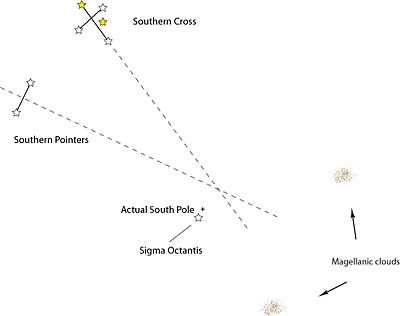Polar alignment
Polar alignment is the act of aligning the rotational axis of a telescope's equatorial mount or a sundial in parallel with that of the Earth. There are various ways to achieve this.
Alignment Methods
The method to use differs depending on whether the alignment is taking place in daylight or in night. Furthermore, the method differs if the alignment is done in the Northern Hemisphere or Southern Hemisphere. The purpose of the alignment also must be considered. For example, the demand for accuracy is much more significant in astrophotography than in occasional stargazing.
Aim at a Pole Star Method
Northern Hemisphere
Sighting on Polaris the North Star is the usual procedure for aligning a telescope mount parallel to the Earth's axis.[1] Polaris is approximately three quarters of a degree from the North Celestial Pole and is easily seen by the naked eye.
Southern Hemisphere
σ Octantis the South Star. Sigma Octanis is, at magnitude 5.6, is difficult for inexperienced observers to locate in the sky. Its declination of -88° 57′ 23″ places it within 1° 2′ 37" of the South Celestial Pole.

Rough Alignment Method
This method can sometimes be adequate for general observing through the eyepiece or for very wide angle astro-imaging with a tripod-mounted camera. Newcomers to amateur astronomy with an equatorial mount telescope should initially adopt this method.
The procedure for rough alignment in the Southern Hemisphere is as follows:
Step 1 Set up the telescope and mount.
Step 2 Use a spirit level to ensure it is level.
Step 3 Set the latitude adjustment pointer of the mount to the latitude of your global observing position.
Step 4 Using a magnetic compass, align the mount with Magnetic South.
Step 5 Realign the mount by the angular difference between the South Magnetic Pole and the Celesial Pole. This varies greatly world wide and is entirely dependent on the global location of the observer.
The procedure for rough alignment in the Northern Hemisphere is to visually align the telescope mount with Polaris.
Rough alignment followed by drift alignment is required for astro-imaging through a telescope.
Drift Alignment Method
A rough alignment is performed - then refined by pointing at different stars and observing any drift that occurs. The mount is then adjusted according to the direction of the observed drift.
The procedure for the Northern Hemisphere is as follows:
Step 1 Point the telescope at a star due South that is close to declination 0 degrees.
Step 2 Rotate the guider CCD or reticule eyepiece in the telescope so that moving the mount in Right Ascension causes the star to follow a crosshair line very accurately. Consider this line to be the ‘horizontal’. If the mount’s tracking is switched off for a few minutes the star should follow this line.
Step 3 Position the star exactly on the centre of the cross hairs.
Step 4 Leave the mount tracking and note the drift direction of the star away from the crosshair centre.
Step 5 While watching the position of the star, put a hand on the front of the scope and push gently either up or down - enough to move the star visibly. Figure out if you need to push UP to re-centre the star or DOWN.
Step 6 If you need to push UP, use the azimuth adjustment to rotate the whole mount clockwise (imagine looking at the mount from above). If you had to push DOWN, rotate the mount anti-clockwise. Start with a small rotation to get a sense of how much change the rotation will produce.
Step 7 Go back to step 4. Keep repeating steps 4 to 7 until the star does not drift up or down for at least 5 minutes. (Remember, sideways drift is not important).
Step 8 Now point the scope at a star low in the West.
Step 9 Centre the star perfectly and let the mount track until a drift is observed.
Step 10 Put a hand on the front of the scope and give a gentle push. If you have to push the scope UP to re-centre the star, then you must increase the angle that the polar axis makes with the horizontal. If you need to push DOWN then the angle must be reduced. (It is probably wise to figure out which way the adjustment knobs move your mount in daylight before you do the actual drift alignment. It is quite easy to get confused in the dark and go the wrong way.)
You should then repeat the whole procedure until no drift is seen for 10–20 minutes.
Equipment used in polar alignment
Crosshair Eyepiece
A crosshair eyepiece is an ordinary ocular with the only difference that it has a crosshair for aiming and measurement of the angular distance. This is useful in any type of polar alignment, but especially in drift.
Auto guiding systems
Dedicated Polar scope
A small telescope usually with an etched reticle that is inserted into the rotational axis of the mount.
See also
- Celestial pole
- Setting circles
- Inertial guidance system
- Tpoint
References
External links
- Polar alignment - Starizona
- How to polar align your equatorial mount - Celestron
- Drift method of polar alignment - Astrosurf
- LX200 polar alignment procedure - Philip Perkins